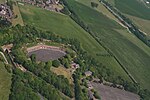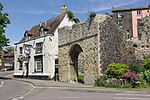The Duke of York's Royal Military School, more commonly known as the Duke of York's, is a co-educational academy (for students aged 11 to 18) with military traditions in Guston, Kent. Since becoming an academy in 2010, the school is now sponsored by the Ministry of Defence, and accepts applications from any student wishing to board. Before 2010, only those students whose parents were serving or had served in the armed forces were eligible.With the transition to academy status, the school became a state boarding school (it is a member of the State Boarding Forum and Boarding Schools Association). During this time, oversight transferred from the Ministry of Defence to the Department for Education.The Duke of York's is steeped in military traditions and history, resulting in practices that include ceremonial parades and uniforms. It has a monitorial style of education modelled on the English public school system.Notable alumni include senior generals (e.g. Sir Archibald Nye, Gary Coward and David Mark Cullen), musicians (Henry Lazarus), athletes (Maurice Colclough), scientists (e.g. Professors Paul Shaw, Timothy Foster, Kevin Allmark and Mark Gardiner) and clergymen (James Jones and Bill Ind).












